|
The DaQo'tah Forge "Targhorn"
The working blade of a true warrior.
On this page we will review many of the different design aspects of the DaQo'tah "Targhorn".
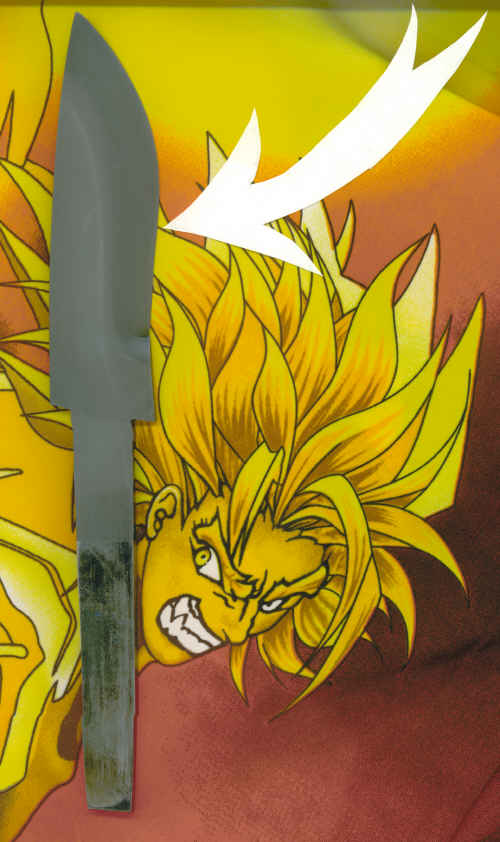
The DaQo'tah Forge Targhorn is a member of the next generation of working blades. It was developed over the coarse of the last few years to answer the need for a more easily carried sheath knife, that would still out-cut any other knife found on the market. The design of the Targhorn gives the warrior the power expected of a truly inspired blade, while not giving up the comfort and safety that is demanded of todays modern knife user.
.
THE STEEL
The first thing we will go over is the steel that has been chosen for the Targhorn.
The name of our Targhorns steel is called 52100 High carbon steel. It is steel that lends itself to the forgeing technique of the master blade smith.
The steel is hand forged using the historical methods of a coal fed fire, hammer and anvil.
The skill of the bladesmith comes out in the heart and spirit of the forged blade. The results of the fire and hammer can be easily seen when the forged knife if put to the test against the finest blades,
Pound for pound, a forged 52100 steel blade can consistently out cut the same steel blade that was only produced via stock-removal.
Along with the correct steel used to make the Targhorn, there is employed a sophisticated heat treating method that brings out the true capacities of this steel to cut.
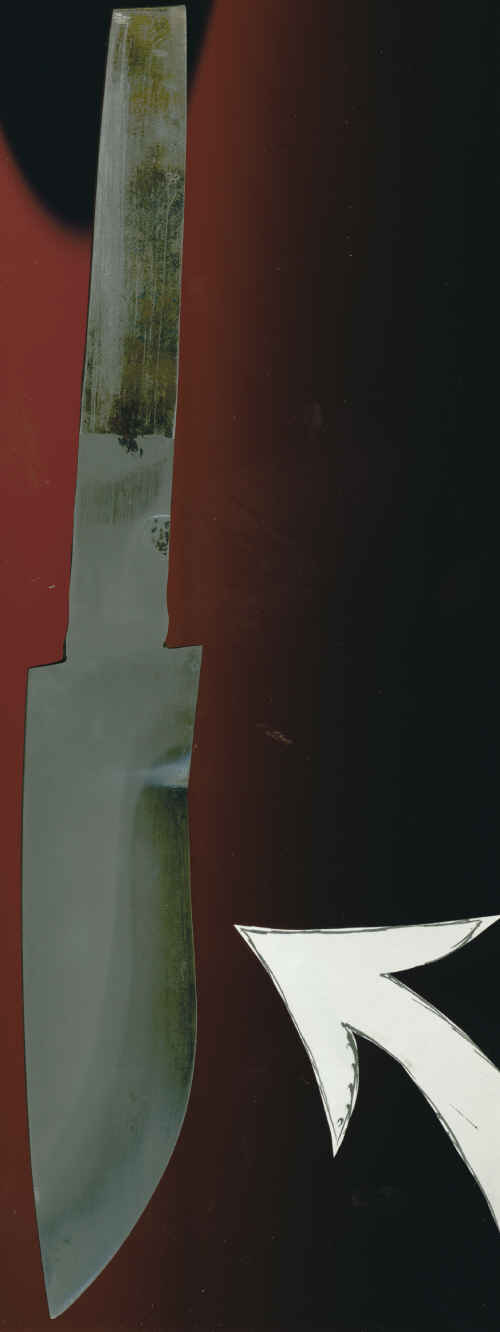
The Triple Quench
There are three separate heat treatments where the Targhorn blade is torched to the critical stage of nonmagnetic, then plunged into a Blood-oil quench held at 160 degrees. Each such heat treatment is separated by a cooling off period of at least 24 hours to allow the steel to settle prior to the next heat treatment.
Following the last such quenching, the blade is then tempered in a tempering oven heated to 400 degrees for 3 different sessions of 2 hours each. Again each such tempering is followed by another 24 hour settling pause to allow the steel to calm itself before the next tempering begins.
The blade is ground and polished to a mirror-reflecting surface, and then the whole blade is etched in a special acid bath.
The Etch
The etching of a knife blade in an acid etch, reveals the secrets of the blade to the blade smith. The etch shows if the blade received the proper heat treatment. All Targhorns are etched, because a Targhorn is a blade that is not ashamed to show what lives in her heart. The Targhorn is a blade that a warrior may need to depend on, for sometimes a Targhorn is all a warrior will have to save his own life. There is no room in a warriors hand for a knife that is untested or that has a construction history that is in doubt.
Notice the lines on the side of the blade after the etch on the Targhorn steel. Such lines indicate the size of the grain of the steel. The steel near the back or spine of the blade has larger grain, meaning it is soft, indicating the steel remained soft. A soft spine is very import for it will allow the blade to flex without breaking. Notice the transition zone where the grain pattern of the steel begins to tighten up, until you reach the cutting edge where little grain is visible.
Not many blades on the market in todays world are etched to review their hidden secrets as this one is,,,,they wouldnt dare.

The Dropped Point.
The point of the Targhorn has a modified drop point. The dropped point is a point that drops below the upper spine edge of the blade, This type of point is excellent for the skinning of animals for it will resist the tendency to poke thought the hide. The dropped point also places the center of gravity more under the fingers as delicate cuts are made. The dropped point also doubles as an effective spear point in battle situations and will not hang up on clothing when used in emergencies like other points , such as the Bowie clip-point tend to do.
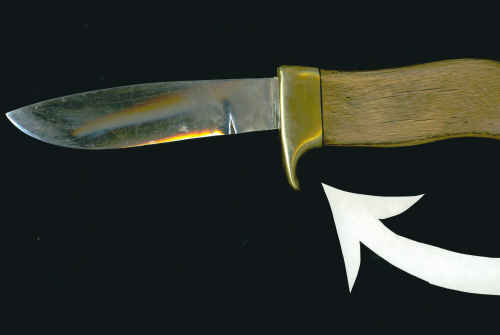
The Guard
The Targhorn has a full guard made of ¾ inch brass. This allows the warrior to have confidence that his hand will not accidentally slide up onto the cutting edge during heavy use. The brass guard is shaped to fit the hand, and cradle the fingers allowing the user to not expend energy nor waist time thinking about how to grip the knife. The hand slides into place and is caressed in to the safety of the protecting guard. This type of guard is called a Pierced guard. Pierced meaning in this case that the guard extends all the way around the steel of the blade. This surrounding of the blade gives the guard more support to stay where its meant to stay. The shoulders of the blade push against the brass guard, so the more you work with the blade and put pressure on the guard, the tighter the fit to the blade the guard becomes.
"Its not going anywhere".

NO Choil.
Most knives have a flaw in their design and its called the choil,(the small cut out section of the blade before it runs into the ricasso). The choil is a terrible design element in most knives, allowing whatever the user wanted to cut to get caught and bunch up underneath the cutting edge. the Targhorn does not have a choil! And it never will.
This lack of a choil allows whatever is being cut to slide from the guard right up onto the cutting edge of the blade. There is no embarrassing bunching up of material, and no snagging.
This lack of a choil is one of the most important design elements of the Targhorn. It alone separates the DaQo'tah Forge Targhorn from the vast majority of terrain blades.
Notice the finger friendly ricasso area just in front of the guard. This allows a person to choke-up on the blade with out extending a finger onto the dangerous cutting edge. A good healthy ricasso is a sign of a well-planned blade design.
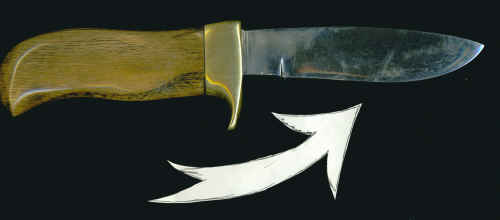
The Convex edge
Unlike most such blades, the Targhorn has a convex edge. This is unlike the more popular flat ground edge we see in most knives. The convex edge supports the cutting edge in superior fashion then any other shape found on knives. The shape of the convex edge lends its self to the tried and true easy method of sharpening with a strop, as found in many barbershops. The convex edge will out-cut other types of edges, and when it does need sharpening, it will sharpen faster and more consistently over time than any others as well.
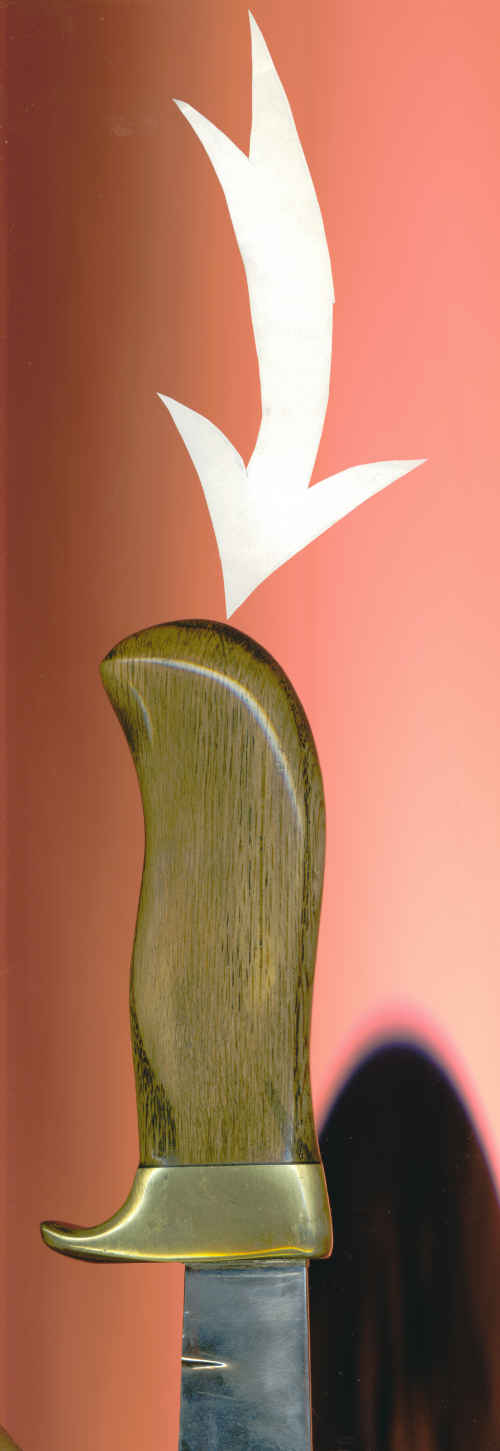
The Rounded End.
No knife is any good if you always end up hurting yourself trying to use it.
The Targhorn has a rounded aft end to allow the pounding of the blade into thick material with ease.
There are no sharp points to scratch, or steel nuts that always have to be tightened.
The Targhorn handle is in all ways, User-friendly.
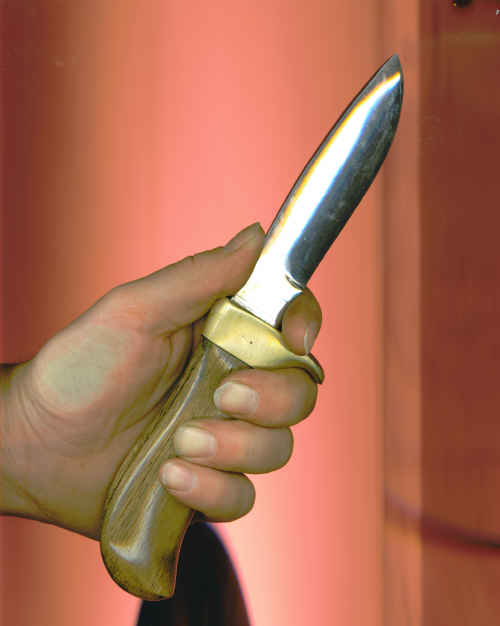
The grip
When you hold the handle of a Targhorn in your hands, it feels like its actually part of your hand, as if it grew with your hand on the end or your arm.
Nothing about the handle of the Targhorn is without purpose, there are no silly frills here, nothing that has a cuteness to it. The Targhorn is an all business knife blade, and its meant to be taken seriously
This is the most widely used of ways to hold the Targhorn, notice the comfortable way the hands seems to blend with the knife. Choking up on the blade to make those more exacting cuts is done with ease. The large guard supports the fingers, and holds them in place, yet allows the fingers room to move as wellthe importance of a correctly designed knife and handle is clearly demonstrated in this photo

The spine of the Targhorn is wide, up to ¼ inch wide to allow the thumb to press on it without digging into the skin.
Too many knives have sharp edges along the spine that tear the skin with use. The Targhorn is built to be worked hard all day with out injury to the user. There is no sign of any thumb rests or slots meant to stick to the thumb, such ideas look good on paper, but in the real world, when used on a blade that is actually worked hard, will only lead to blisters if you are lucky, and stitches if you are not.
| 52100 steel |
|
|
| blade is etched to show heat treating lines |
| Brass Guard |
|
|
| oak Handle with shovel handle wood for the Spacer |
|

